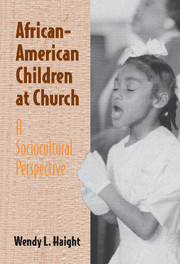Book contents
- Frontmatter
- Contents
- List of Tables
- Acknowledgments
- PART ONE OVERVIEW
- PART TWO PATTERNS OF SOCIALIZATION AND PARTICIPATION
- 4 African-Americans in Salt Lake City: A Historical and Social Overview
- 5 The Teachers
- 6 Adults' Perspectives on Spiritual Socialization
- 7 Narratives Related during Sunday School
- 8 Socialization and Participation through Storytelling
- 9 Adult–Child Verbal Conflicts
- 10 Other Contexts for Socialization and Participation
- PART THREE RELATIONSHIPS OF RESEARCH AND PRACTICE
- PART FOUR CONCLUSION
- References
- Index
8 - Socialization and Participation through Storytelling
Published online by Cambridge University Press: 10 August 2009
- Frontmatter
- Contents
- List of Tables
- Acknowledgments
- PART ONE OVERVIEW
- PART TWO PATTERNS OF SOCIALIZATION AND PARTICIPATION
- 4 African-Americans in Salt Lake City: A Historical and Social Overview
- 5 The Teachers
- 6 Adults' Perspectives on Spiritual Socialization
- 7 Narratives Related during Sunday School
- 8 Socialization and Participation through Storytelling
- 9 Adult–Child Verbal Conflicts
- 10 Other Contexts for Socialization and Participation
- PART THREE RELATIONSHIPS OF RESEARCH AND PRACTICE
- PART FOUR CONCLUSION
- References
- Index
Summary
In this chapter, I will focus on some social aspects of storytelling. First, I will explore the ways in which teachers and children in Sunday School participate together in storytelling. The impact of narratives on children's development depends, in part, on the ways in which children are involved in telling and listening to stories. Mehan, Lintz, Okamoto, and Willis (1995) criticized an African-American Christian academy as containing highly structured, teacher-centered classrooms in which children were not encouraged to have meaningful discussions about different perspectives. In chapter 6, adults at First Baptist Church described socialization beliefs and practices that displayed some overlap with the interpretation of Mehan et al., in that the adults viewed themselves as leading children in acquiring critical cultural knowledge. However, adults' descriptions of their beliefs and practices also differed profoundly from the interpretations of Mehan et al., in that they emphasized the importance of actively involving children in the learning process. In this chapter, I will describe the simultaneous ways in which teachers lead and children actively participate in storytelling at First Baptist Church.
Second, I will describe some socialization strategies through which teachers highlighted for children key concepts within narratives. Narratives are important to socialization, in part because stories communicate that particular events are meaningful and why (e.g., see Haden, Haine & Fivush, 1997; Labov & Waletzky, 1967; Ochs & Capps, 1996; Polanyi, 1985). Stories are told to make a point, often including the narrator's moral evaluation or critical judgments (e.g., Polanyi, 1985).
- Type
- Chapter
- Information
- African-American Children at ChurchA Sociocultural Perspective, pp. 105 - 128Publisher: Cambridge University PressPrint publication year: 2001



